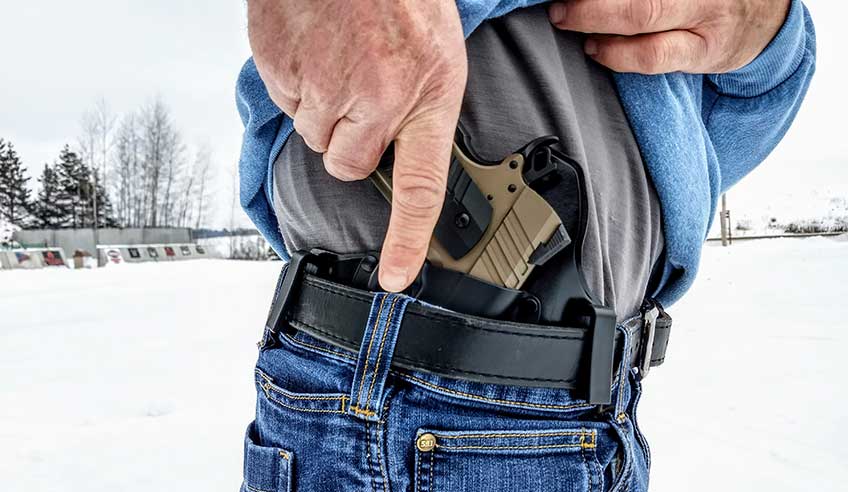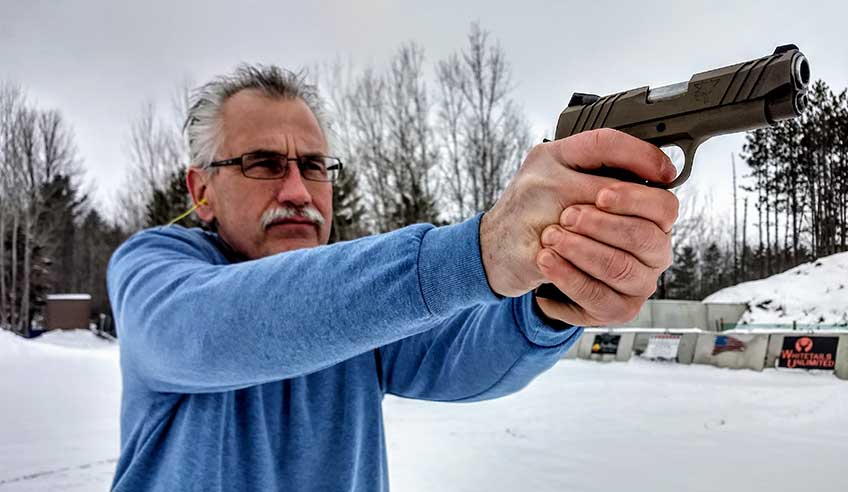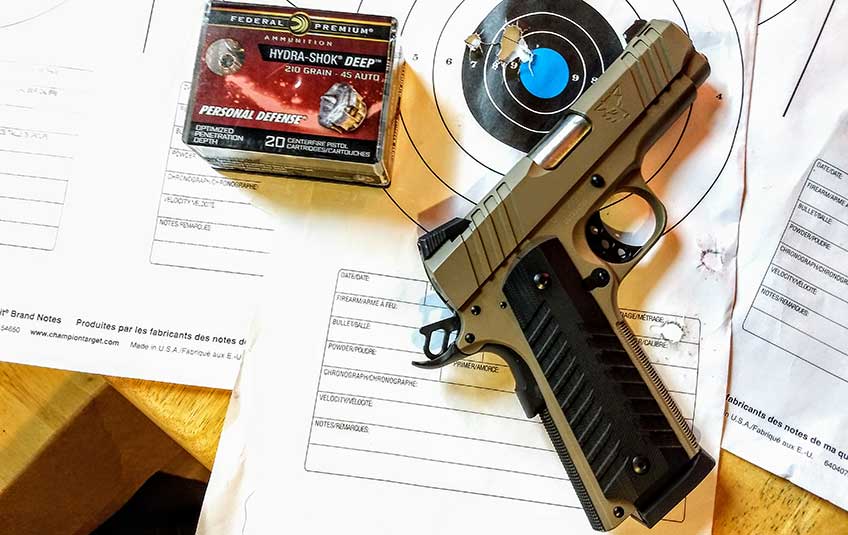
Recently, I discovered one such option in the Devil Dog Arms (DDA) 3.5 Standard 1911. The “3.5” in the model name refers to the length of the match-grade barrel. However, the frame on the 3.5 Standard is actually that of a full-size 1911, so the 3.5 Standard also takes a standard-size magazine with 8+1 capacity. Traditionally, the full-size 1911 with a 5” barrel, generally known as the Government model, and the somewhat shorter Commander with it 4.25” barrel sported full-size 1911 frames (there are internal differences between the two models, including rail sizes and slightly different placement of the impact abutment). Yet, the more compact Officer 1911 with its 3.5” barrel historically had its own smaller frame. This is not the case with the DDA 3.5 Standard. That full-size frame also means it takes full-size grips for better stability while shooting.

My 3.5 Standard featured a Cerakote finish in Flat Dark Earth. Other features included a heat-treated and machined frame, built from 4140 domestic investment cast steel. The slide is also heat-treated and machined from domestic billet steel sporting a custom flat top and 45-degree design. This is in addition to deep oversized front and rear serrations, which aid in racking back the slide. Front and back strap are etched in very tactile 22LPI checkering. The DDA 3.5 Standard has a manual safety on the left side on the back of the frame, as well as a grip safety just below the bobtail. The front post sight on the 3.5 is pinned and has a white dot, while the Kensight rear sight is drift-adjustable and has white dots on either side of the notch.
I did a quick run to my range and ran a couple of magazines through my 3.5 Standard using Remington Ultimate Defense handgun ammunition. I drilled some nice groups at 5 and 10 yds. and, satisfied that the 3.5 Standard could as needed, spent the next week carrying the pistol concealed. My first holster choice was the Sticky Holster I use for small-of-the-back carry with a Smith & Wesson M&P 45 Shield. The DDA 3.5 fit the holster fine but, in the end, didn’t work out too well. There was nothing wrong with the holster by itself, as it works great with my 45 Shield. But given the extra weight of the 3.5 Standard versus the 45 Shield (33 oz. versus 20.5 oz. unloaded), the Sticky Holster didn’t have the rigidity necessary to comfortably carry the 3.5 Standard.

Next, I tried out a pair of holsters from Galco Gunleather, the Corvus Belt and Kingtuck Classic. They were much better choices for carrying the DDA 3.5 Standard. The Kingtuck Classic is an Inside the Waistband holster and the kydex pocket fit the DDA 3.5 Standard well. The Kingtuck also provided good support for the DDA 3.5 and was fairly comfortable in my daily carry. Of course, the Kingtuck was new and would feel better after a longer break-in period. The Kydex construction of the Corvus Belt felt good and correct from the first time I wore it with the DDA 3.5 Standard. The forward-molded design of the Corvus Belt holster held the pistol at just the right angle on my belt. It also came with hardware to make it an inside-the-waistband holster plus belt slots for both 1.5” and 1.75” wide belts.
There are no two ways about it; if you carry the DDA 3.5 Standard, you are going to have to figure out best carry practices for the pistol. That includes your holster and clothing choices so that the beavertail doesn’t get in the way and snag during the draw. For myself, I found that the Corvus Belt holster was the best choice, as it canted the rear of the pistol slightly away from my body and belt. This allows the back of my hand to push away my clothing from the beavertail. That was another reason the IWB Kingtuck holster didn’t work as well nor as quickly for drawing the DDA 3.5 Standard. Being closer to the body, that holster didn’t allow the back of my hand to push aside my clothing as effectively as the Corvus.

For accuracy and general function testing, I used three brands of .45 ACP ammunition in the DDA 3.5 Standard: American Eagle with a 230 gr. full metal jacket, Federal Premium’s 210 gr. Hydra-Shock, and Remington’s High Terminal Performance with a 230 gr. jacketed hollow point. For my accuracy testing, I shot at my local outdoor range. Located in North-central Wisconsin, the range is outdoors and as a result the conditions were what one would expect in winter. Temperatures ranged from 8 to 14 degrees Fahrenheit. There was more than a foot of snow on the range too. So, I shot from 7 yds. offhand and standing on the snow, and then later at 20 yds. from a rest. I didn’t use gloves and so had to stop shooting several times to warm my hands.
At 7 yds. average, five shot groups with all three brands of ammunition hovered between 1.25” and 1.5." The American Eagle pegged one five shot group at 1.5," but the first four shots came in at an impressive .71." The Hydra-Shock’s best was five shots at .97." My last seven rounds with the Hydra-Shock scored a 1.6” group, while five of those shots placed at 1.07." I likely would’ve shot a little more accurately without the heavy winter coat and the uneven snow-covered ground. Of course, a self defense pistol is made for a self-defense scenario, and those scenarios rarely come complete with prime shooting conditions. From the rest at 20 yds., I was able to average 2” to 2.5” with all three brands of ammo.

The DDA 3.5 Standard does have a more snappy recoil than a full-size 1911. Of course, the shorter barrel and the full-size frame paired with a full-capacity magazine mean that more weight is going to be at the rear of the 3.5 Standard versus a full-size 1911. Muzzle flip is a reality, but once I got used to it, I had no trouble accounting for the snappy recoil and keeping myself on target for follow-up shots. The trigger on the DDA 3.5 Standard measured a crisp 3 lbs., according to my Lyman Electronic Trigger Pull Gauge. It had just the slightest bit of takeup. I had two failures to feed correctly with the Remington HTP ammunition on the second day of my testing. I looked over the pistol and decided it needed a good cleaning (it had come to me with a fair amount of shooting already done), especially the feed ramp. After cleaning, I experienced zero malfunctions over the next 80 rounds it took me to finish my shooting.
DDA offers the 3.5 Standard in a Black Oxide or Boron Nitride finish, in addition to the Cerakote FDE finish of my test pistol. The 3.5 is available in 9 mm also, which is one oz. heavier than the .45 ACP model. Unloaded, the ammunition capacity for the 9 mm DDA 3.5 is 10+1. I liked the DDA 3.5 Standard a good deal. It is accurate and functions well and has the feel and heft of a 1911 without the all the size of a Government model. Truthfully, I am not looking forward to sending it back to DDA, I like carrying it so much. MSRP is $1,149, for more information on the 3.5 Standard visit devildogarms.com.
Devil Dog Arms 3.5 Standard Specifications
Part Number: DDA-350-BO45
Frame Style: Standard, full sized
Caliber (as tested): .45 ACP
Barrel Length: 3.5"
Barrel Material: Stainless Steel
Frame: Domestic investment-cast steel
Slide: Domestic 41040 steel
Finish (as tested): Cerakote FDE
Length: 7 3/8″
Weight: 2 lbs. 1 oz.
Sights: White dot front post; drift adj rear notch with two dots
Trigger: Three-hole aluminum
Safeties: Manual and grip
Magazine Capacity: 8 rounds
Misc: Ships with two magazines, carry case, cable lock and owner’s manual
MSRP: $1,149




































